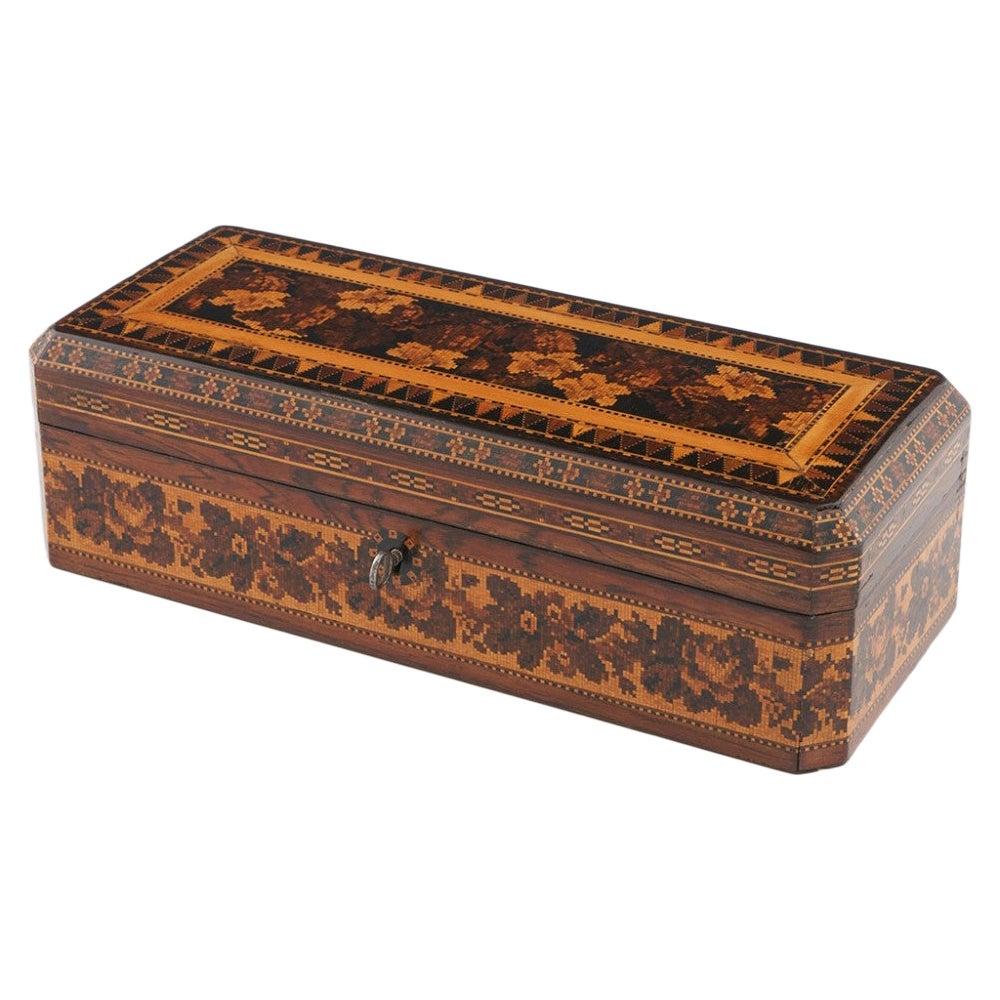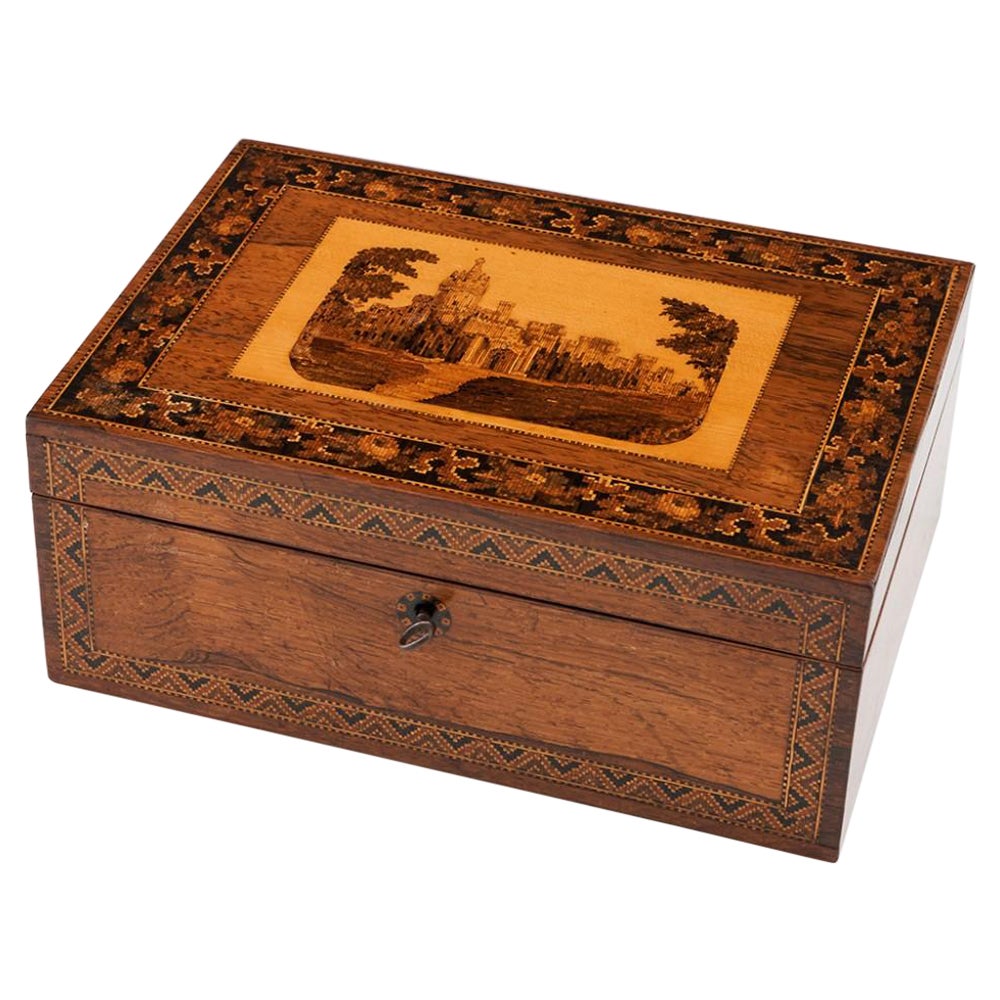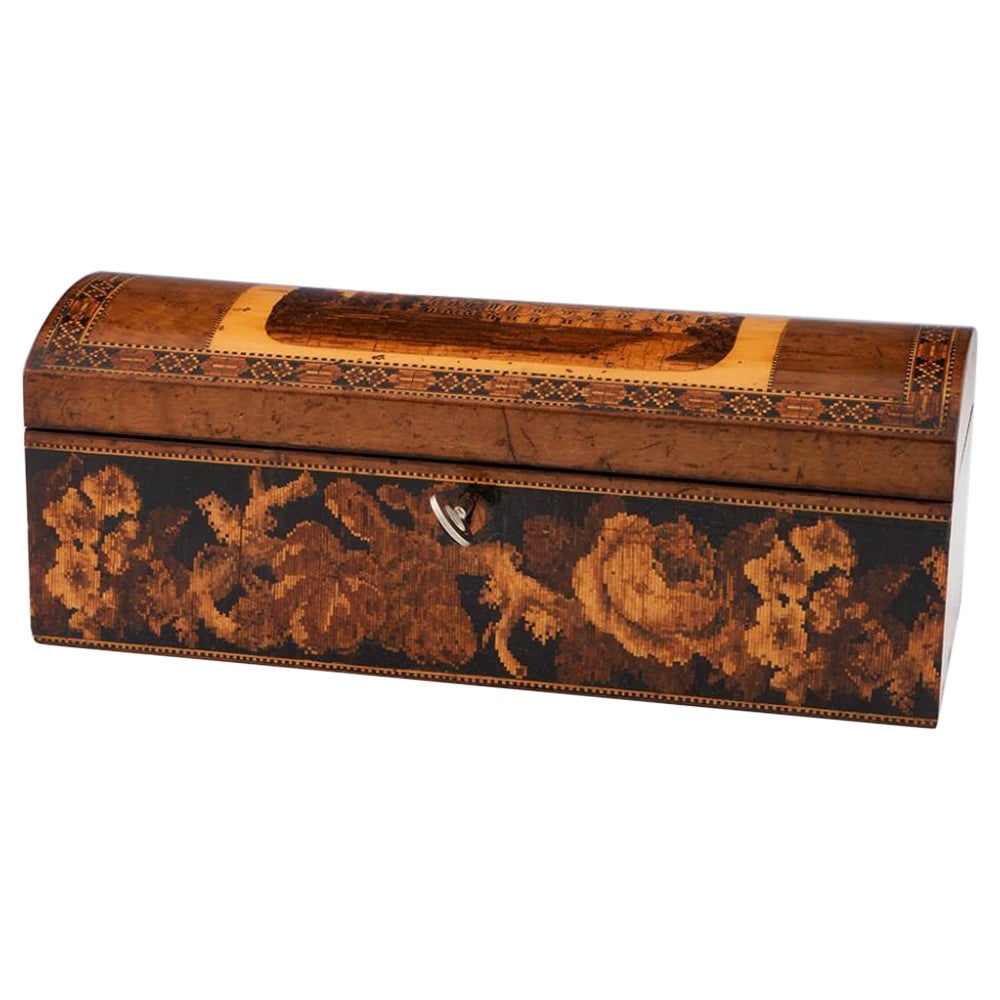Items Similar to Tunbridge Ware Four Drawer Table Cabinet c1860
Want more images or videos?
Request additional images or videos from the seller
1 of 10
Tunbridge Ware Four Drawer Table Cabinet c1860
About the Item
Heading : Tunbridge ware four drawer table cabinet
Date : c1860
Period : Victoria
Origin : Tunbridge Wells, Kent
Decoration : Central abstract foliate design within angled keylines, gemoetric broder within keylines. There is geometric stickware banding to the side panels of the cover, also within keylines. To the front of the cabinet is an image of Hurst Wood cottage within keylines. There is a chain like border also within keylines. Internally there are four boxes of decreasing size from top to bottom, each with a different stickwear geometric band.
Size : 15.6cm height,17cm width, 12cm depth
Condition : Excellent, there is one missing tessera to the front right of rthe keylines around the stickewear border.
Restoration : Some tesserae have been repaired
Weight : 751 grams
Hurst Wood Cottage is one of the less common topographical designs and is in fact a misnoma. The original basis for the design is an engraving in Colbran's New Guide for Tunbridge Wells and the cottage is in fact a farmhouse belonging to Viscount Nevill that was built in the style of a Tudor yeoman's house. It was situated on Rusthall Common but no longer exists. The design was used by many makers and as such attribution has proven difficult.
- Dimensions:Height: 5.91 in (15 cm)Width: 6.7 in (17 cm)Depth: 4.73 in (12 cm)
- Style:Victorian (Of the Period)
- Materials and Techniques:
- Place of Origin:
- Period:
- Date of Manufacture:1860
- Condition:Wear consistent with age and use.
- Seller Location:Tunbridge Wells, GB
- Reference Number:
About the Seller
5.0
Gold Seller
These expertly vetted sellers are highly rated and consistently exceed customer expectations.
Established in 2014
1stDibs seller since 2023
34 sales on 1stDibs
Typical response time: 5 hours
- ShippingRetrieving quote...Ships From: Tunbridge Wells, United Kingdom
- Return PolicyA return for this item may be initiated within 30 days of delivery.
More From This SellerView All
- Tunbridge Ware Glove Box c1860By Tunbridge WareLocated in Tunbridge Wells, GBHeading : Tunbridge ware glove box Date : c1860 Period : Victoria Origin : Tunbridge Wells, Kent Decoration : Cover with a berlin woolwork floral mosaic within keylines bordered by v...Category
Antique 1860s British Victorian Decorative Boxes
MaterialsWood
- Tunbridge Ware Wedge Shaped Stationery Box, c1860Located in Tunbridge Wells, GBTunbridge Ware Wedge Shaped Stationery Box, c1860 Additional Information: Heading: Tunbridge Ware - A Wedge Shaped Stationery Box Date : c1860 Period : Victorian Origin : Tunbridge ...Category
Antique 19th Century English Victorian Decorative Boxes
MaterialsSatinwood
- Eridge Castle Tunbridge Ware Tea Caddy c1860By Henry HollambyLocated in Tunbridge Wells, GBHeading : Two compartment Tunbridge ware tea caddy Date : c1860 Period : Victoria Origin : Tunbridge Wells, Kent Decoration : The cover decorated with Hollamby's version of Eridge Ca...Category
Antique 1860s British Victorian Tea Caddies
MaterialsWood
- Tunbridge Ware Two Compartment Sarcophagus Tea Caddy c1860By Tunbridge WareLocated in Tunbridge Wells, GBHeading : Tunbridge ware sarcophagus tea caddy Date : c1860 Period : Victoria Origin : Tunbridge Wells, Kent Decoration : Central floral mosaic bordered by a geometric pattern within...Category
Antique 1860s British Tea Caddies
MaterialsWood
- Tunbridge Ware Sewing Box with Eridge Castle Topographic Mosaic, c1860Located in Tunbridge Wells, GBTunbridge Ware Sewing Box with Eridge Castle Topographic Mosaic, c1860 Additional Information: Heading: Tunbridge Ware - A Sewing Box with E...Category
Antique 19th Century English Victorian Decorative Boxes
MaterialsSatinwood
- Tunbridge Ware - A Round Topped And Square Ended Glove Box, c1860By Henry HollambyLocated in Tunbridge Wells, GBTunbridge Ware - A Round Topped And Square Ended Glove Box - Battle Abbey Cloisters, c1860 Additional Information: Heading: Tunbridge Ware - A Round Topped And Square Ended Glove Bo...Category
Antique 19th Century English Victorian Decorative Boxes
MaterialsSatinwood
You May Also Like
- Tunbridge Ware BoxLocated in Dallas, TXLarge Tunbridge ware box with herringbone pattern inlaid parquetry. Circa 1840, England.Category
Antique 1840s English Decorative Boxes
MaterialsWood
- Victorian Tunbridge Ware Tea CaddyLocated in Bedfordshire, GBA Charming 19th Century Tunbridge Ware Tea Caddy With Attractive Floral Band To Main Body And Parquetry Perspective Cubes To Hinged Lid Enclosing Lidded Interior. Tea was an extrem...Category
Antique Mid-19th Century English Victorian Tea Caddies
MaterialsOther
- Regency Tunbridge Ware Sewing BoxBy Tunbridge WareLocated in Northampton, GBFitted Interior & Silver Handles From our Tunbridge Ware collection, we are delighted to offer this Tunbridge Ware Sewing Box. The Sewing Bo...Category
Antique Early 19th Century British Regency Decorative Boxes
MaterialsSatinwood
- Brighton Pavilion Tunbridge Ware Sewing CompendiumBy Tunbridge WareLocated in Northampton, GBRare Tunbridge Ware Form Sewing Compendium From our Tunbridge Ware collection, we are delighted to offer this very rare Tunbridge Wear Sewing Compendium. The Sewing Compendium modelled as a tower from the Brighton Pavilion features the iconic minaret turned in Sycamore (aka white wood) and a large globular body with hand-painted details leading to further turned faces and the hand-painted windows upon a stepped base. The Sewing Compendium opens in two locations one just below the first dome revealing a pin cushion and the second just above the windows revealing the Sewing tools including a Tunbridge Ware thimble and bobbin. The Tunbridge Ware Sewing Compendium dates to the Georgian era during the reign of George IV circa 1825. Brighton Pavilion, The Royal Pavilion and surrounding gardens are a Grade I listed property and were the former Royal residence located in Brighton, England. It was built in 1787 in three stages as a seaside retreat for George, Prince of Wales who became the Prince Regent in 1811 and then King George IV in 1820. It is built in the Indo-Saracenic style prevalent in India for most of the 19th century. The current appearance of the Pavilion which has various domes and minarets, is the work of architect John Nash, who extended the building starting in 1815. George IV's successors William IV and Victoria also used the Pavilion but Queen Victoria decided that Osborne House should replace the Pavilion as the royal seaside retreat and therefore the Pavilion was sold to the city of Brighton in 1850. Indo-Sarascenic refers to a cross between Indian architecture and Muslim architecture. Minarets means beacon in Arabic. In Islamic religious architecture, the tower from which the faithful are called to prayer five times each day by a muezzin, or crier. Such a tower is connected to a mosque and has one or more balconies or open galleries. The inspiration for the minarets features on the Brighton Pavilion are in homage to these types of finials. John Nash (1752-1835) was one of the most prevalent British architects from the Georgian and Regency periods. He was responsible for the design, in the neoclassical and picturesque styles of many important areas of London. He was financed by the Prince Regent and by the era's most successful property developer, James Burton. Nash's most famous designs were the Brighton Pavilion, Marble Arch and Buckingham Palace. Sycamore is a member of the Maple family, found in Europe. It is light yellow in colour and is often a very clean wood, with a straight, fine grain. The wood is often pippy. However, these pips are usually a very similar colour to the rest of the wood making them hardly visible. Georgian, a period in British history dating from 1714-1837, the Georgian era after the Hanoverian kings George I, George II, George III and George IV. Tunbridge Ware Tunbridge Wells and Tunbridge in Kent, England became popular in the 17th Century for their therapeutic waters. By the 18th century, Tunbridge Wells was a hugely popular Spa resort. Shops and stalls were set up to sell local work of distinction to visitors as souvenirs. Many of the original boxes were decorated with all sorts of different kinds of designs. Many of the Tunbridge boxes...Category
Antique Early 19th Century British George IV Decorative Boxes
MaterialsWood, Sycamore
- 19th Century British Tunbridge Ware Lap DeskBy Tunbridge WareLocated in Dallas, TXPresenting an absolutely gorgeous and extremely unique and rare 19th Century British Tunbridge ware lap desk. This lap desk is unlike any of it’s kind we have seen before. From cir...Category
Antique Mid-19th Century English High Victorian Decorative Boxes
MaterialsWood, Ebony, Maple, Satinwood, Walnut
- Quality antique Victorian tunbridge ware inlaid tea caddyLocated in Ipswich, GBQuality antique Victorian tunbridge ware inlaid tea caddy having a lovely antique Victorian tunbridge ware inlaid tea caddy with beautiful detail to the box opening to reveal two rec...Category
Antique Early 19th Century Victorian Tea Caddies
MaterialsWood
Recently Viewed
View AllMore Ways To Browse
Russian Lacquerware
Kings Box
Basket With Handle And Boxes
Austria Pill Box
Kpm Box
Barbedienne Box
Antique Kashmir Papier Mache
Cat Trinket Box
Bone Sewing Tools
Shaker Bentwood
Accordion Sewing Box
Weller Decorative Box
Small Rectangular Art
Middle Eastern Boxes
Chestnut Box
Sewing Cushion
Espelt Box
Bernhardt Allure





